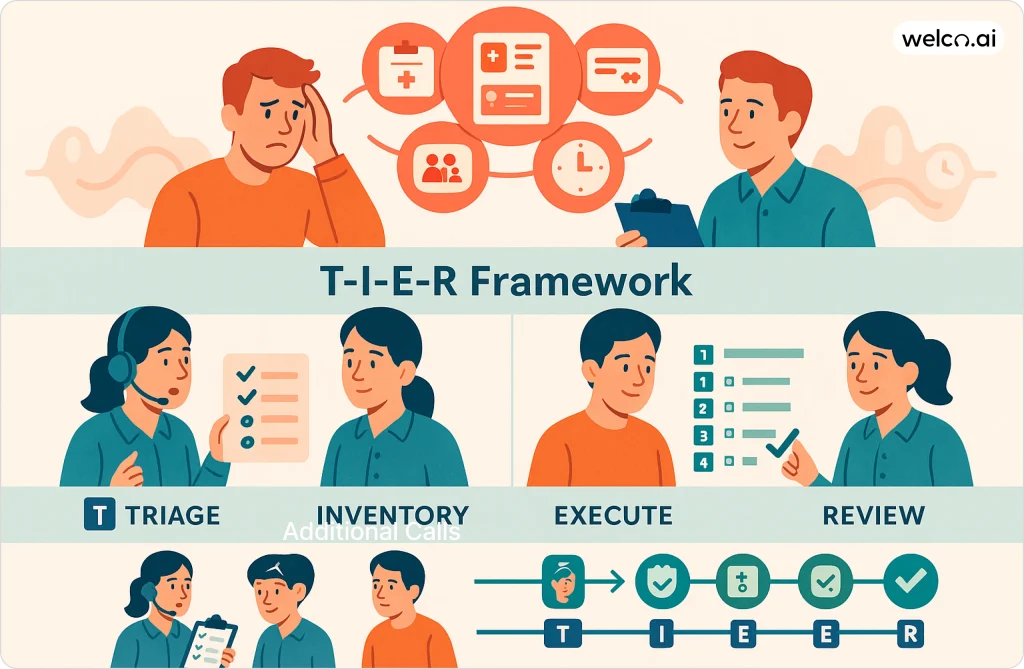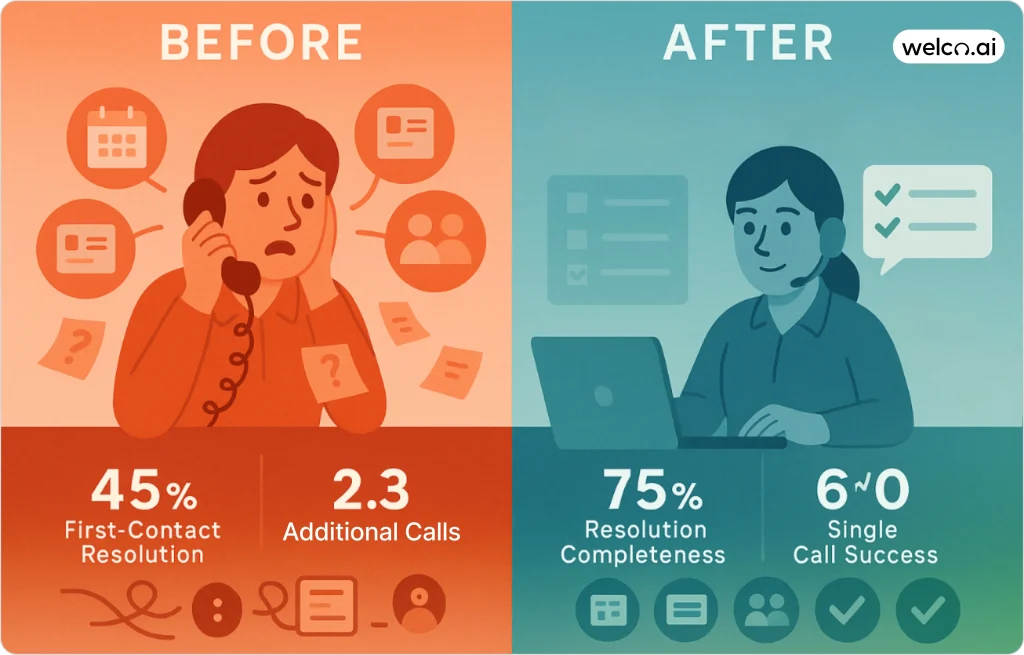Last month, I listened to Maria, a healthcare receptionist, handle what should have been a routine call. The patient needed to reschedule an appointment, check insurance coverage, get test results, and add a family member to their account. By the end of the 12-minute call, both Maria and the patient were frustrated, nothing was resolved, and the patient hung up saying they’d “figure it out themselves.”
That 12-minute call cost the practice more than just time—the patient switched to a competitor the following week, taking her entire family’s business with her. A $2,400 annual revenue loss from one mishandled complex interaction.
This scenario plays out thousands of times daily across businesses. Complex customer interactions—those involving multiple interconnected issues—are where most customer service systems break down completely.
The difference between businesses that excel at complex interactions and those that fumble them isn’t technology or staff size. It’s having systematic approaches that acknowledge how human communication actually works under stress. Understanding the psychology behind call routing decisions becomes especially crucial when customers are already dealing with multiple interconnected issues.

Why Complex Interactions Break Down
When customers call with multiple issues, several psychological factors create perfect storms for failure:
Cognitive Load Multiplication: Each additional issue doesn’t just add complexity—it multiplies it. A customer juggling appointment scheduling plus insurance questions plus family concerns quickly exceeds their mental processing capacity.
Emotional Escalation: Frustration compounds with each unresolved piece. What starts as a simple scheduling request becomes an emotionally charged experience if customers feel unheard or dismissed.
Context Switching Difficulty: Both customers and staff struggle to maintain context across different topics. Insurance verification requires different mental frameworks than appointment scheduling, and switching between them creates confusion.
I’ve watched receptionists lose track of customer requests after handling just two connected issues. The cognitive burden falls on both sides of the conversation.
The Hidden Costs Most Businesses Don’t Track
Beyond obvious metrics like call duration, complex interactions create cascading costs that most businesses never measure:
Repeat Contact Rates: Unresolved complex calls generate an average of 2.3 additional contacts as customers try to complete what should have been handled initially.
Staff Cognitive Fatigue: After handling multiple complex interactions, staff performance degrades for subsequent calls. The mental exhaustion from context switching affects their ability to serve other customers effectively.
Customer Relationship Damage: Failed complex interactions damage trust more severely than simple service failures. When customers invest significant time explaining multiple issues only to achieve partial resolution, they feel genuinely betrayed.
Competitive Vulnerability: Frustrated customers actively seek alternatives after poor complex interaction experiences. Unlike simple service failures that customers might forgive, complex interaction failures often trigger immediate competitor research.
The TIER Framework for Complex Interactions
After working with dozens of customer service teams across different industries, I noticed that successful interactions followed a consistent pattern. I call this the TIER framework, and it’s transformed how businesses handle their most challenging customer calls:

T – Triage and Acknowledge
Before attempting to solve anything, acknowledge the complexity and set realistic expectations.
What this sounds like: “I can hear you have several important things to address today. Let me make sure I understand everything you need, and then I’ll work through each item systematically so we don’t miss anything.”
Why it works: This immediately signals competence and reduces customer anxiety about being dismissed or rushed.
When I first started implementing this framework, I made the mistake of rushing through the Triage phase. Customers could tell I was just going through a checklist rather than genuinely acknowledging their situation. The key is authentic recognition of complexity, not just procedural acknowledgment. For businesses looking to optimize this critical first moment of contact, understanding how first impressions are formed in 100 milliseconds can significantly enhance the effectiveness of the Triage step.
I – Inventory and Prioritize
List all issues and help customers identify what’s most urgent.
What this sounds like: “Let me confirm what we’re handling: rescheduling your Tuesday appointment, checking your insurance coverage for the new medication, reviewing your test results, and adding your daughter to your account. Is the appointment rescheduling most time-sensitive since it’s coming up?”
Why it works: Customers feel heard, and explicit prioritization prevents important issues from being forgotten.
E – Execute Systematically
Handle one complete issue before moving to the next, with clear transitions.
What this sounds like: “Perfect, I’ve got your appointment moved to Thursday at 2 PM and you should receive a confirmation text shortly. Now let’s check on that insurance coverage for your diabetes medication…”
Why it works: Completing full issues creates psychological closure and builds confidence for remaining items.
R – Review and Confirm
Summarize all resolutions before ending the interaction.
What this sounds like: “Before we finish, let me confirm everything we accomplished: your appointment is rescheduled for Thursday at 2 PM, your insurance covers 80% of the medication with a $24 copay, your test results are normal and Dr. Smith will discuss them Thursday, and I’ve started the process to add your daughter to your account. Is there anything else I can help with today?”
Why it works: Explicit confirmation prevents follow-up calls and demonstrates thoroughness.
Training Your Team for Complex Interactions
Complex interaction skills require different training approaches than standard customer service preparation:
Conversation Flow Practice
Role-play scenarios involving 3-4 interconnected issues. Most customer service training focuses on single-issue resolution, leaving staff unprepared for complexity.
Training Exercise: Create scenarios where customers need appointment changes, insurance verification, and account updates simultaneously. Practice maintaining context while switching between different business systems.
Emotional Regulation Under Complexity
When handling multiple issues, both customers and staff experience increased stress. Train staff to recognize their own cognitive load limits and use specific techniques to maintain calm professionalism.
Training Focus: Breathing techniques, voice modulation under stress, and explicit acknowledgment phrases that buy processing time (“Let me pull up that information for you” creates a natural pause).
System Integration Mastery
Staff need seamless familiarity with all business systems involved in complex interactions. Fumbling between appointment software, insurance databases, and account management tools destroys the flow needed for complex resolution.
Training Requirement: Staff should practice accessing multiple systems simultaneously and maintaining conversation flow while navigating different interfaces.
Technology Integration Strategies
While human skills remain crucial, technology can support complex interaction management:
Context Preservation Systems
Implement systems that maintain customer conversation history across different service channels. When customers call back about partially resolved complex issues, staff should see complete interaction context immediately.
Integration Workflows
Design workflows that allow staff to update multiple systems from single interfaces. If appointment rescheduling also requires insurance verification and account updates, systems should facilitate these connected actions.
Escalation Protocols
Create clear protocols for when complex interactions exceed staff capabilities. Rather than frustrating customers with incomplete resolution, systematic escalation maintains service quality. For businesses serving diverse customer bases, implementing comprehensive multilingual capabilities can prevent language barriers from turning routine interactions into complex escalation scenarios.
Industry-Specific Applications
Different industries face unique complex interaction challenges:
Healthcare Practices
Patient calls frequently involve appointment management, insurance concerns, prescription issues, and family coordination simultaneously. HIPAA compliance adds complexity layers that require specialized training.
Common Scenario: “I need to reschedule my surgery consultation, verify whether my new insurance covers the procedure, understand what prep work I need to do, and find out if my husband can attend the appointment.”
Framework Application: Triage medical urgency first, handle insurance verification while accessing appointment systems, provide prep information, and confirm family attendance policies.
Legal Services
Client calls often combine case updates, billing questions, document requirements, and deadline concerns. Confidentiality requirements affect how information can be shared and documented.
Common Scenario: “I got served with papers yesterday, I think it’s related to that contract dispute we discussed, there’s a deadline next Friday, and I need to know what this means for my business license renewal.”
Framework Application: Assess legal urgency, review case files for context, explain deadline implications, and coordinate with appropriate attorneys for business license concerns.
Financial Services
Client interactions frequently involve account management, investment questions, regulatory concerns, and planning decisions that require careful documentation and compliance consideration.
Common Scenario: “I need to update my beneficiary information, understand how the recent market changes affect my retirement timeline, and find out if I should adjust my contribution amounts before the tax deadline.”
Framework Application: Handle account changes with proper verification, provide market context without giving specific advice, and coordinate with advisors for personalized planning guidance. For financial services organizations looking to enhance these interactions further, developing personalized automated customer interaction strategies can help staff adapt communication styles to individual client preferences and complexity tolerance levels.
Measuring Complex Interaction Success
Traditional customer service metrics often miss the nuances of complex interaction management:
Resolution Completeness Rate
Track what percentage of complex interactions achieve full resolution in the initial contact versus requiring follow-up.
Target: 75% complete resolution for interactions involving 2-3 issues, 60% for interactions involving 4+ issues.
Context Retention Accuracy
When complex interactions do require follow-up, measure how accurately context is preserved and communicated to subsequent staff.
Measurement: Follow-up interactions should not require customers to re-explain previously discussed issues.
Customer Effort Perception
Survey customers specifically about complex interactions to understand their effort perception, not just satisfaction.
Key Question: “How easy was it to accomplish everything you needed during your call today?”
Staff Confidence Metrics
Monitor staff confidence levels specifically around complex interactions through regular check-ins and performance observations.
Indicator: Staff should report feeling prepared and supported when handling multi-issue customer requests.
Common Implementation Mistakes
Avoid these pitfalls that undermine complex interaction management:
Assuming Technology Solves Everything
Advanced phone systems and AI tools can support complex interactions but cannot replace systematic human training and frameworks.
Reality Check: Technology amplifies existing capabilities—if staff lack complex interaction skills, technology won’t magically create them.
Underestimating Training Time Requirements
Complex interaction skills require significantly more practice time than basic customer service skills.
Planning: Allow 3-4x more training time for complex interaction competency compared to simple issue resolution.
Ignoring Emotional Components
Focus solely on process efficiency while neglecting the emotional dynamics of complex interactions leads to technically correct but relationally damaging outcomes.
Balance: Efficiency matters, but emotional acknowledgment and patience often determine customer satisfaction more than speed.
Inconsistent Application
Having frameworks for complex interactions but not consistently applying them across all staff and situations creates unpredictable customer experiences.
Solution: Regular practice sessions and quality monitoring specifically focused on complex interaction scenarios. For businesses ready to implement systematic approaches to consistency, developing comprehensive journey mapping frameworks can help ensure that complex interaction protocols are applied uniformly across all customer touchpoints.

Your Implementation Strategy
Building complex interaction capabilities requires systematic development:
Week 1-2: Assessment and Analysis
- Record examples of current complex interactions
- Identify common multi-issue patterns in your business
- Survey customers about their complex interaction experiences
- Assess current staff comfort levels with complex scenarios
Week 3-4: Framework Development
- Adapt the TIER framework to your specific business context
- Create training materials for common complex scenarios
- Develop escalation protocols for situations exceeding staff capabilities
- Design quality monitoring specifically for complex interactions
Week 5-8: Training and Practice
- Train staff on the adapted framework using role-playing exercises
- Practice with progressively complex scenarios
- Implement peer coaching for complex interaction skill development
- Begin monitoring complex interaction outcomes
Week 9-12: Optimization and Refinement
- Analyze complex interaction performance data
- Refine training based on real-world challenges
- Adjust frameworks based on customer feedback
- Develop advanced techniques for especially challenging scenarios
The Competitive Advantage
Businesses that excel at complex interactions create sustainable competitive advantages:
Customer Loyalty: Customers who experience excellent complex interaction resolution become significantly more loyal than those who only receive basic service.
Word-of-Mouth Marketing: Successful complex interaction resolution generates powerful referrals because customers share stories about businesses that “actually solved my complicated problem.”
Staff Satisfaction: Teams trained in complex interaction management report higher job satisfaction because they feel capable of genuinely helping customers rather than just processing requests.
Operational Efficiency: Systematic complex interaction management reduces overall call volume by resolving multiple issues simultaneously rather than generating repeat contacts.
The businesses winning customer loyalty aren’t necessarily those with the newest technology—they’re the ones whose staff can handle the messy, complicated, human reality of customer needs with competence and care.Complex interactions will always be part of customer service. The question is whether your business approaches them strategically or hopes they’ll somehow resolve themselves. The framework and training strategies outlined here provide a systematic approach to turning your most challenging customer interactions into opportunities for building lasting relationships. For organizations looking to ensure consistency across all customer touchpoints, developing a comprehensive voice brand identity helps maintain the same level of care and competence whether interactions are simple or complex.
Frequently Asked Questions
My team gets overwhelmed when customers call with multiple issues at once. How do I know if this is really a “complex interaction” problem or just poor training?
Complex interaction problems have specific patterns: customers calling back within 24 hours to “follow up” on supposedly resolved issues, staff expressing frustration about calls that “should have been simple,” and complaints that mention feeling like they’re “getting the runaround.” If your team can handle single issues well but struggles when customers have 2-3 connected requests, that’s a complex interaction training gap, not a general customer service weakness.
When I try to implement the TIER framework, my staff says it takes too long and slows down call times. How do I balance efficiency with this systematic approach?
This is the most common pushback I hear, and it’s actually backwards thinking. TIER feels slower initially because staff are being thorough for the first time, but it dramatically reduces total interaction time. One complete 8-minute TIER interaction replaces three separate 5-minute calls where customers repeat themselves. Track “resolution completeness” rather than individual call duration—you’ll see the efficiency gains within 2-3 weeks of proper implementation.
What if customers get impatient during the “Inventory and Prioritize” step and just want me to start solving things immediately?
I’ve seen this challenge repeatedly. The key is framing it as urgency acknowledgment rather than delay: “I want to make sure I handle everything you need today so you don’t have to call back. Let me quickly confirm what we’re addressing…” Most customers appreciate knowing you’re being systematic rather than scattered. For truly urgent situations, modify the approach: “I hear this is urgent—let me handle that first, then we’ll address your other items.”
How do I train my team to recognize when they’re experiencing cognitive overload during complex calls?
Staff cognitive overload shows up as forgetting details from earlier in the conversation, asking customers to repeat information they’ve already provided, or feeling flustered when switching between different business systems. Train your team to notice these warning signs and use the processing time phrases I mentioned: “Let me pull up that information for you” or “Give me just a moment to access the right system.” These create mental reset opportunities.
Our customers often have complex issues that span multiple departments. How do I prevent the dreaded “transfer shuffle” while still getting them to the right specialist?
This is where the “Review and Confirm” step becomes crucial. Before any transfer, summarize everything you’ve learned and what still needs resolution: “I’ve handled your appointment rescheduling and insurance verification. Now I need to transfer you to our billing specialist for the payment plan question. I’ll send them all this context so you won’t need to repeat anything.” Warm transfers with complete context prevent the shuffle that destroys customer trust.
